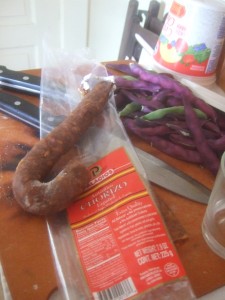Building a Basil Economy
By Danny Mayer
I first started eating grits last summer while seeking out breakfast options at Wine+Market. Up to that time, my $5 purchase of eggs, either from the farmer’s market or at Wine+Market, provided the basis for many of my breakfasts.
The W+M grits purchase was something of a calculated risk for me. I had developed strong negative associations with the grain ever since a series of conversations with my childhood friend Jeffrey Bollerman. Jeff was part of the Jessie F. George School gang in New Jersey that I hung out with up through fourth grade when I left for Charlotte, North Carolina. At 10, Jeff was already worldly traveled, having once spent a week in the far-away sticks in South Carolina at a place he called Hilton Head, a town so backward, he claimed, that many of the roads were dirt and the only thing to eat there were these things called grits.
“Grits. Nothing but grits,” was all he would say to me, arms akimbo and face still incredulous, for the last four months I would ever see him. I was mortified.
As I got older, my disdain for grits, which was really based in a general northern-based youthful fear and dislike of most things southern, did begin to wan. I went to a southern college,married a girl from South Georgia. After a number of high school and college years spent eating at Waffle House, not to mention a good deal of reading about and cooking food, I came to understand that grits were more accurately a lower-class southern cuisine, a part of both poor white and black culinary traditions. Field food. I liked them, sort of.
My intellectual attraction to grits did not really alter my psycho-somatic dislike of the homely grain. Bollerman’s southern gothic imagination still had a strong hold on me. A one-night experiment while in college with Waffle House’s bland bowl of cheap grits was all it took to convince me that the grain just wasn’t worth its price in salt and butter. My body told me: if you’re going cheap, get the bacon.
But as I continued to read and cook, I grew to resent it when grits began to appear, often for an outsized non-homely price, on foodie menus throughout the South (and particularly in Charleston, SC, where I lived before moving to Lexington), often accompanied with something like shrimp and heavy portions of nice cheddar cheeses to justify the inflated price. I resented seeing rich clientèle inflating the value of grits, good grits. I resented that I noticed the stark class-based polarity in grit consumption, that they either cost $13 and (presumably) were good, or that they were $2 and overly bland and buttery. Until I went in search of breakfast grocery items at W+M, grits as a viable food option had never seriously crossed my mind. You could say I was forced into it: culinary desire by creative downsizing.
My first sack
A month before my first grits purchase I had dropped $10 at W+M on a big sack of Weisenburger corn meal, most likely inspired by the corn bread dinners I’d heard about at the home of Rona Roberts and Steve Kay. I never quite got my money out of that sack—I made very little corn bread last summer—but it did pave the way for my rethinking of the Bollerman prophecies and dropping $7.95 at the store to test a different Weisenburger grain, their yellow grits. The purchase was, at the outset, derived from my intention to bend my desires to fit what the store offered—and not to head off to larger stores where my selections of breakfast foods would be greatly expanded. Call it learning by downsizing.
And what a great learning experience it’s been. Grits are great, easy and quick to cook, not to mention immensely versatile in the kitchen. In winter, when my mornings are more hectic and I desire a quickly-made food to coat my stomach and provide warmth and energy during the frigid 3-mile walk to BCTC’s campus, I can make an early-morning bowl of cheese grits using milk in about 10 minutes. In summer, when I do not teach and have more time on my hands, I use water instead of milk and herbs instead of cheese, and spend 30 minutes to an hour cooking it down as a late-morning brunch, often forgetting about it as I set about folding clothes in the bedroom, organizing my mess of an office, doing last night’s dishes or gathering produce from our garden. I simply keep adding water to the grits and occasionally stir until I finish doing whatever it is that I’m doing. A stoner with strong ADD tendencies, even I can’t burn this shit.
Grits economics
Of course, finding a food to suit my psycho-social make-up is one thing, being able to afford it on a regular basis is quite another. At its most simple, grits only require water, a small cooking pot and, for taste, a little salt and/or pepper. My $8 purchase of grits nets me about 15 meals. The basis of the meal, then, costs around 50 cents.
To be sure, the inherent flexibility of grits means that I normally add other things depending on my mood and the season. Herbs, onions and garlic, for me virtually free items grown in my garden, are choice in summer (and keep my costs down). In the winter, I add the expense of cheese grated from either pecorino or cheddar cheese hunks I purchase at W+M. Though I don’t buy cheese solely for its use in grits, I’d conservatively estimate that 15 meals of cheese grits would cost another $15 at W+M, bringing the total food cost for cheese grits, a filling and tasty breakfast if there ever was one, to close to $1.50 per meal. Both cheese hunks and grits store for a long time, only increasing their flexibility in the kitchen.
The economics of the meal allow me to do two things. First, I am able to buy my grits from Wine+Market even though they cost more here, meaning I don’t have to deal with an out-of-the-way trip to Kroger or the Co-Op. Second, the cheapness of grits allows me to buy Weisenburger products, a locally sourced company from Midway that offers a variety of flours and grains.
I buy Weisenburger because first because it’s what’s available at Wine+Market. But buying Weisenberger also helps my money stay closer to its source than, say, the cheaper (and more bland) Quaker Oats variety found on the shelves of Kroger (nearby their Weisenburger offerings).
I also prefer Weisenberger out of a general desire to maintain regional cooking. I used to spend time watching well-paid globe-trotting chefs at the Food Network take trips to unique sections of Italy, and I used to pore through travel magazines that waxed poetic about expensive restaurants who hocked different regional cuisines for many a scheckel. At some point I realized that the very term that I enjoyed, regional cuisine, had arisen through limited choices—a type of flour, a sort of salt, a type of grape or potato grown or easily procured nearby. At its base, regional food is peastant food, the very word, regional, implying a sense of limits that the rich–myself included–have rarely abided by.
I choose Weisenburger flours and grains, much like I travel to Wine+Market, in part to help foster an emplaced taste to what I eat. I make do with what’s available and possible. I believe there are beneficial social repercussions to this orientation, though that’s a topic for another article.
A grits and chorizo recipe
My go-to grits meal for this season has been, unquestionably, grits and chorizo.
I use Palacio’s Chorizo, a slightly-processed chorizo from Spain that I purchase because it is conveniently sold at W+M for $10 a packet. I’ve come to value Palacio’s because like grits it too is versatile. It can stay in my fridge for many weeks without going bad, which has allowed me to think of different ways to incorporate small hunks of the spicy meat into a variety of dishes I cook—breakfast, lunch and dinner. I normally get between 5 and 6 servings out of it when using it solely for chorizo, or somewhere close to 2 ounces of chorizo per meal. The reduced size helps me limit my meat intake. Counting the chorizo cost into my grits, the breakfast costs around $2.50.
Of course, one doesn’t have to purchase their grits and chorizo from Wine+Market; the taqueria and grocery store nearby me on Seventh and Maple, for example, has a cheaper chorizo, a mexican style oddly made in the USA, that comes as an unprocessed raw meat. It can’t stay in the fridge as long as Palacio’s, and its texture is more like ground beef than salami; however, the mexican-style chorizo more intensely flavors the grits, a good thing for those who cook for many people. Blue Moon Garlic at the Farmer’s Market also sells a local chorizo, in links, that should work similar to the mexican chorizo, though I haven’t tried this as I normally purchase brats instead from Blue Moon ($6 for 4 brats that, with bread and mustard, comprise the basis for four solid summer lunch meals).
All these options work, and importantly, all are available to a wide diversity of urban and sub-urban shoppers—different classes, life-schedules and geographical locations around the city’s inner-suburban core—if only we shoppers make the effort.





Leave a Reply